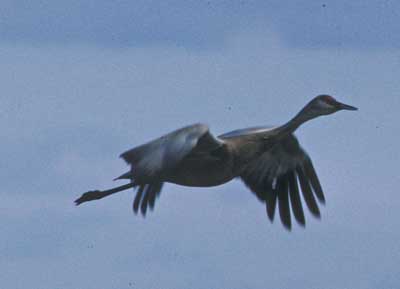Lesser Sandhill Crane, Grus canadensis canadensis
High-Priority Species ListSampling locations: Sampling will be conducted primarily on the Seward Peninsula, and the northern portion of Norton Sound, and on St. Lawrence Island, to optimize the chances of encountering birds returning from Chukotka. Potential sites include: Kuzitrin River Flats west of Imuruk Basin; Sinuk River and Safety Lagoon near Nome, and coastal flats near Moses Point, Koyuk River, and Shaktoolik River Flats in Norton Bay. St. Lawrence Island is also a primary site if sufficient sampling is feasible (Kawerak Corp. estimated that Gambel and Savoonga took > 250 cranes in 2002). Secondary locations will include Creamers Field Migratory Waterfowl Refuge (state) in Fairbanks, and public hunting areas in the Tanana Valley near Delta Junction.
Sampling timeframe: Birds returning from Asia in August and early September will be targeted. Tanana Valley migration and hunting occurs throughout September.
Sample demographics: Given the likely difficulty in obtaining samples, birds of all ages and sex will be targeted.
Methods of capture: Most samples will be obtained from subsistence hunters (Aug-Sept), sport hunters (1-30 Sept), or through scientific collection. A few samples may be obtained from birds rocket-netted during late summer and early autumn at Creamers Field in Fairbanks.
Other targeted species: Several other avian species returning to Alaska from eastern Siberia could possibly be sampled on St. Lawrence Island and the Seward Peninsula, including many on the list of 26 high priority species noted in the National Plan.
Contact: Julian Fischer
Selawik NWR
Alaska Department of Fish and Game
Contact: Tom Rothe
Fairbanks Regional Office (Creamers Field Waterfowl Refuge)
Delta Junction Area Office
Kawerak Inc. (Seward Peninsula, Nome area, St. Lawrence Island)
McIvor, D. E., and M. R. Conover. 1991. Sandhill Crane habitat use in northwestern Utah and southwestern Wyoming. Pp. 81-84 In Proceedings of the sixth North American Crane Workshop,
Regina, Saskatchewan. Guynes Printing Co., Albuquerque, New Mexico.
Portenko, L. A. 1981. Birds of the Chukchi Peninsula and Wrangel Island. Nauka Publishers, Leningrad. Translated from Russian. Published for the Smithsonian Institution and the National Science Foundation, Washington, D.C.
Tacha, T. C., S. A. Nesbit, and P. A. Vohs. 1992. Sandhill Crane (Grus canadensis). In The Birds of North America, No. 31 (A. Poole, P. Stettenheim, and F. Gill, eds.). Philadelphia: The Academy of Natural Sciences; Washington, DC: The American Ornithologist's Union.
Tacha, T. C., S. A. Nesbitt, and P. A. Vohs. 1994. Sandhill Crane. Pp. 77-94 In Migratory Shore and Upland Game Bird Management in North America. Allen Press, Lawrence, Kansas.

Ranking Score: 11.5
Asian H5N1 ranking criteria for Lesser Sandhill Crane, Grus canadensis canadensis.
Total of partial contact with Asia1 |
Contact with known "hot spot"2 |
Habitat used in Asia3 |
Pop. in Alaska4 |
Can samples be obtained? |
Score |
2.0 |
1.0 |
3.5 |
3.0 |
2.0 |
11.5 |
Unknown numbers of mid-continent population breed in Siberia |
No known use of AI-infected areas |
Breeds in wet or moist tundra meadows, near wetlands, or on barrier islands; often feeds in agricultural areas where available |
Alaska population believed to be in the low tens of thousands |
Could be difficult to obtain target numbers |

